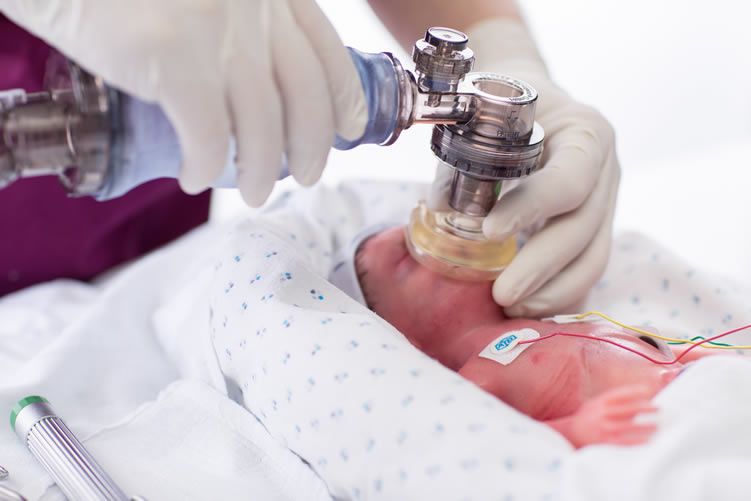High Emotion Simulation – our Paul
The world’s smallest high-end patient simulator for highly realistic neonatal simulation training.
With a size of 35 cm and a weight of 1000g, Paul is an accurate recreation of a baby born preterm in the 27th week of pregnancy. He was developed by experts in the fields of neonatology, special effects design and animatronics. His internal and external anatomy is a like-for-like copy of a preterm baby. The highly realistic upper airway makes it possible for the first time to conduct realistic training exercises to provide high-quality care to preterm babies in all possible areas of specialization.
With Paul, SIMCharacters is taking the next step in the future of medical simulation. Paul's convincingly life-like external anatomy, in combination with specific preterm pathologies which can now be simulated for the first time, allow participants to experience in-depth training scenarios which improve the learning outcome and training success. High fidelity was yesterday – the future belongs to High Emotion Simulation.
 „Caring for a preterm baby is highly complex, time-critical and, therefore, extremely challenging. SIMCharacters has set itself the objective of improving the quality of care for critically ill preterm and newborn babies – this is why we have developed Paul.“
„Caring for a preterm baby is highly complex, time-critical and, therefore, extremely challenging. SIMCharacters has set itself the objective of improving the quality of care for critically ill preterm and newborn babies – this is why we have developed Paul.“
Jens-Christian Schwindt
Neonatologist and CEO
What can Paul do?
Paul sets new standards in the field of simulating physiology and pathology specific to preterm infants: It is now possible to simulate clinical conditions such as respiratory distress syndrome (RDS) in a highly realistic and unprecedented way. Paul’s lifelike external and internal anatomy and the realistic simulation of clinical conditions specific to preterm babies, combined with an innovative approach to managing the simulator and monitoring vital data, enable simulation training of a previously unimaginable quality. The entire system comprises the preterm baby simulator Paul, the control computer with the required software and a patient monitor. Paul is controlled and operated without the need for any wires.
- Pathological breathing patterns (nasal flaring, paradoxical respiration, substernal retractions, groaning / grunting)
- Highly realistic upper airway, ideal for practicing endotracheal intubation and special neonatological care strategies (LISA, INSURE)
- Mechanical ventilation using bag-mask and Perivent systems
- Automatic tube position detection during intubation
- Physiological and pathological lung parameters for machine-assisted ventilation
- Palpable pulse on the umbilical cord and all four limbs
- Sensors to detect the correct position and depth of an umbilical venous catheter (UVC)
- Auscultatory respiratory, heart and intestinal noises
- Cyanosis and hyperoxia

 „One of our objectives when developing Paul was to make his external appearance as lifelike as possible and thus almost indistinguishable from a real preterm baby. The more realistic Paul is seen to be, the more intense the emotional attachment and thus the learning success.“
„One of our objectives when developing Paul was to make his external appearance as lifelike as possible and thus almost indistinguishable from a real preterm baby. The more realistic Paul is seen to be, the more intense the emotional attachment and thus the learning success.“
Elentari T. Nepomucky
Head of Product Design
Control
Paul and his patient monitor are controlled using the intuitive user interface developed specifically for High Emotion Simulation. The graphical user interface (GUI) integrated into Paul’s 3D simulation also offers the trainer team a completely new and unique simulation experience. There is already a debriefing system integrated into the GUI. Sensor data (e.g. intubation, inserting an UVC and chest compressions) are automatically transferred to this. In addition, markers can be set and comments made. The SIMCharacters GUI also automatically connects to the A/V debriefing system SIMStation.
- Controlling via 3D simulation of the patient simulator
- Real-time display of all simulator conditions (e.g. chest compressions, tube depth and UVC position, motion artefacts).
- Monitoring parameters can be changed quickly and easily using the control laptop (e.g. parameter display, curve position and color code)
- Simple programming of basic settings and scenarios
- Own debriefing system and automatic integration into SIMStation
„Plug 'n' Train“
Paul is part of a highly mobile simulation system: patient simulator, control laptop and vital signs monitor are ready for use within minutes, easy to transport and therefore ideal for on-site use and training scenarios at different locations.
- Completely wireless operation
- Data transfer via Wi-Fi
- Wireless battery charging
- Up to 1.5 hours of operating time
- Choice of different models for control laptop and vital signs monitor, fully customized to your needs.

 „Not only is Paul deceptively lifelike on the outside, he also has a highly sophisticated technical core. We have been able to enhance and miniaturize cutting-edge components from areas such as microelectronics, sensor technology, mechanics and animatronics. This makes Paul the first preterm baby training model in the world that can realistically simulate specific neonatal pathologies.“
„Not only is Paul deceptively lifelike on the outside, he also has a highly sophisticated technical core. We have been able to enhance and miniaturize cutting-edge components from areas such as microelectronics, sensor technology, mechanics and animatronics. This makes Paul the first preterm baby training model in the world that can realistically simulate specific neonatal pathologies.“
Michael Haller
Head of Research and Development
Why the need for preterm baby simulation?
One in ten newborns is preterm. Simulating training helps to enable these children to survive and, above all, to lead a healthy life – because every action taken in case of an emergency needs to be right.
15 million children are born preterm every year – meaning that approximately 10 percent of all newborns around the world are preterm. Thanks to continuous improvements and innovations in medical techniques, even babies born very prematurely, with a birth weight between 500 and 1000 grams, can have excellent survival rates. Nevertheless, preterm birth remains the most common cause of death among infants.
Preterm babies are also at risk of suffering long-term damage. Sight and hearing disabilities, growth disorders or lung problems are ten times more likely to occur in preterm babies than in full-term newborns. Caring for these children is highly complex, time-critical and, therefore, extremely challenging. Today’s medicine strives for a level of quality that requires the care of these children to be effectively practiced, both to save lives and to improve the children’s quality of life.
“… let us change the future for millions of babies born too soon, for their mothers and families, and indeed for entire countries …”
Ban Ki Moon
UN-Generalsekretär
There is a story behind every statistic ...
July was born in the 25th week of pregnancy, weighing just 600 grams. Fifteen weeks too early.
Caring for such a small preterm baby always presents a great challenge, both professionally and emotionally, even for experienced medical teams. In these situations, not only are technical skills important but also non-technical skills such as effective communication, leadership behaviour and optimal teamwork, which are essential in efforts to ensure the successful care of preterm babies.
These few critical moments in a preterm infant’s initial minutes after birth have a significant impact on the quality of their entire life.
 „Realistic simulation training has long been a fixed part of training and development in high-reliability industries such as aviation. We developed Paul to help make highly realistic training a matter of course in the medical field of preterm baby care.“
„Realistic simulation training has long been a fixed part of training and development in high-reliability industries such as aviation. We developed Paul to help make highly realistic training a matter of course in the medical field of preterm baby care.“
Michael Hoffmann
Head of Business Development
Mission Statement / Our Philosophie
Caring for a critically ill child is complex, time-critical and, therefore, extremely challenging.
In a very short space of time, medical teams must take vital action that may have a major impact on the future life and survival of the child. Whether and how a seriously ill child survives depends directly on the skills and capabilities of the attending team.
Our lifelike patient simulators, developed by a team of experts from the areas of medicine, special effect design and animatronics, are intended to enable medical teams to train for emergencies under highly realistic conditions. Given that we know the excellence delivered by these teams every day, it is our aim to support them with the world’s best and most advanced child simulators.

Team

Jens-Christian Schwindt, MD
Chief Executive Officer

Michael Hoffmann
Head of Finance & Business Development

Michael Haller, MSc
Head of Research & Development

Axana Hellmann
Research Assistant & Back Office

Elentári Tanja Nepomucky
Head of Product Design

Christoph Kunzmann
Special Effects Consultant

Ing. Ewald Unger
Research & Development Consultant

Andreas Kaya-Fill
GUI Development & Design

Andreas Sturl
Software Engineer

Arno Dreschnig
Software Engineer

Ines Obwegeser
Office Management

Fernec Szolar
Management Assistant
„SIMCharacters wants nothing else than to develop the best children simulators in the world – we look forward to introducing you to Paul personally.“
Contact

SIMCharacters GmbH
Ruedigergasse 10,
1050 Wien
E-mail: info@simcharacters.com
Tel/Fax: + 43 1 402 39 75
VAT: ATU 67351778
Company reg.no.: FN 383366 z, Commercial Court of Vienna
Bank: Bankaustria
IBAN: AT05 12000 51607606931
BIC: BKAUATWW
Supported by:


SIMCharacters GmbH
Ruedigergasse 10
1050 Vienna Austria Europe
+43 1 4023975
+43 1 4023975
info@simcharacters.com







